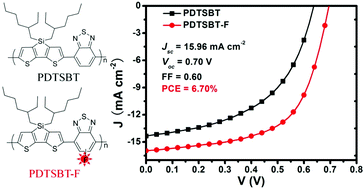Fluorinated low band gap copolymer based on dithienosilole–benzothiadiazole for high-performance photovoltaic device†
Abstract
A new fluorinated low band gap copolymer, poly[(4,4′-bis(2-ethylhexyl)dithieno[3,2-b:2′,3′-d]silole)-2,6-diyl-alt-4,7-(5-fluoro-2,1,3-benzothiadiazole)] (PDTSBT-F), was designed and synthesized. The introduction of fluorine atom to a classical low band gap copolymer (PDTSBT) has a little influence on the polymer absorption spectrum and band gap, which was 1.48 eV for PDTSBT-F. However, the HOMO level was lowered to −5.17 eV for PDTSBT-F, the film crystallinity was improved, and PDTSBT-F showed higher charge carrier mobility than its non-fluorinated analogue (PDTSBT). For the PDTSBT-F/PC71BM device, a Jsc of 15.96 mA cm−2, a Voc of 0.70 V, and a FF of 0.60 were attained, resulting in a PCE of 6.70%. To the best of our knowledge, this is the highest value to date in devices based on copolymers with C-, Si- and Ge-bridged dithiophene as the electron-rich unit and benzothiadiazole derivatives as electron-deficient unit. A high PCE in combination with a wide absorption spectrum in the visible range could induce PDTSBT-F to be a potentially promising low band gap polymer for polymer solar cells.


 Please wait while we load your content...
Please wait while we load your content...